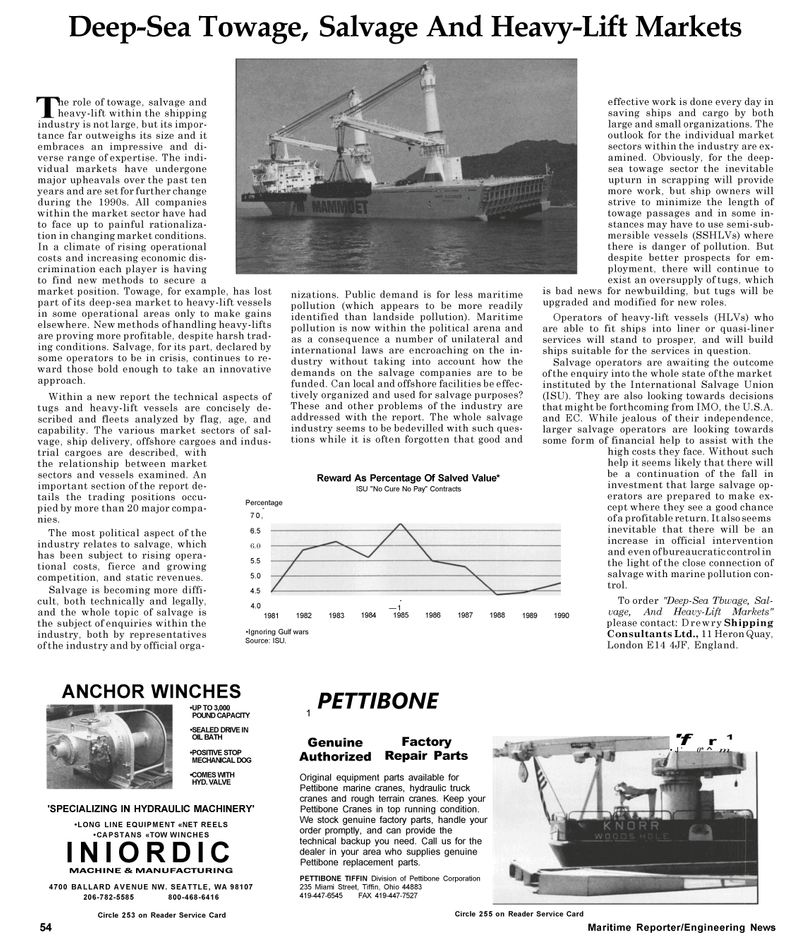
Page 56: of Maritime Reporter Magazine (May 1992)
Read this page in Pdf, Flash or Html5 edition of May 1992 Maritime Reporter Magazine
Deep-Sea Towage, Salvage And Heavy-Lift Markets
The role of towage, salvage and heavy-lift within the shipping industry is not large, but its impor- tance far outweighs its size and it embraces an impressive and di- verse range of expertise. The indi- vidual markets have undergone major upheavals over the past ten years and are set for further change during the 1990s. All companies within the market sector have had to face up to painful rationaliza- tion in changing market conditions.
In a climate of rising operational costs and increasing economic dis- crimination each player is having to find new methods to secure a market position. Towage, for example, has lost part of its deep-sea market to heavy-lift vessels in some operational areas only to make gains elsewhere. New methods of handling heavy-lifts are proving more profitable, despite harsh trad- ing conditions. Salvage, for its part, declared by some operators to be in crisis, continues to re- ward those bold enough to take an innovative approach.
Within a new report the technical aspects of tugs and heavy-lift vessels are concisely de- scribed and fleets analyzed by flag, age, and capability. The various market sectors of sal- vage, ship delivery, offshore cargoes and indus- trial cargoes are described, with the relationship between market sectors and vessels examined. An important section of the report de- tails the trading positions occu- pied by more than 20 major compa- nies.
The most political aspect of the industry relates to salvage, which has been subject to rising opera- tional costs, fierce and growing competition, and static revenues.
Salvage is becoming more diffi- cult, both technically and legally, and the whole topic of salvage is the subject of enquiries within the industry, both by representatives of the industry and by official orga- nizations. Public demand is for less maritime pollution (which appears to be more readily identified than landside pollution). Maritime pollution is now within the political arena and as a consequence a number of unilateral and international laws are encroaching on the in- dustry without taking into account how the demands on the salvage companies are to be funded. Can local and offshore facilities be effec- tively organized and used for salvage purposes?
These and other problems of the industry are addressed with the report. The whole salvage industry seems to be bedevilled with such ques- tions while it is often forgotten that good and
Reward As Percentage Of Salved Value*
ISU "No Cure No Pay" Contracts
Percentage 70, 6.5 6.0 5.5 5.0 4.5 4.0 1981 1982 1983 1984 —1 1985 1986 1987 1988 1989 •Ignoring Gulf wars
Source: ISU. effective work is done every day in saving ships and cargo by both large and small organizations. The outlook for the individual market sectors within the industry are ex- amined. Obviously, for the deep- sea towage sector the inevitable upturn in scrapping will provide more work, but ship owners will strive to minimize the length of towage passages and in some in- stances may have to use semi-sub- mersible vessels (SSHLVs) where there is danger of pollution. But despite better prospects for em- ployment, there will continue to exist an oversupply of tugs, which is bad news for newbuilding, but tugs will be upgraded and modified for new roles.
Operators of heavy-lift vessels (HLVs) who are able to fit ships into liner or quasi-liner services will stand to prosper, and will build ships suitable for the services in question.
Salvage operators are awaiting the outcome of the enquiry into the whole state of the market instituted by the International Salvage Union (ISU). They are also looking towards decisions that might be forthcoming from IMO, the U.S.A. and EC. While jealous of their independence, larger salvage operators are looking towards some form of financial help to assist with the high costs they face. Without such help it seems likely that there will be a continuation of the fall in investment that large salvage op- erators are prepared to make ex- cept where they see a good chance of a profitable return. It also seems inevitable that there will be an increase in official intervention and even of bureaucratic control in the light of the close connection of salvage with marine pollution con- trol.
To order "Deep-Sea Tbwage, Sal- vage, And Heavy-Lift Markets" please contact: Drewry Shipping
Consultants Ltd., 11 Heron Quay,
London E14 4JF, England. 1990
ANCHOR WINCHES •UP TO 3,000
POUND CAPACITY •SEALED DRIVE IN
OIL BATH •POSITIVE STOP
MECHANICAL DOG •COMES WITH
HYD. VALVE 'SPECIALIZING IN HYDRAULIC MACHINERY' •LONG LINE EQUIPMENT «NET REELS •CAPSTANS «TOW WINCHES INIORDIC
MACHINE & MANUFACTURING 4700 BALLARD AVENUE NW. SEATTLE, WA 98107 206-782-5585 800-468-6416
Circle 253 on Reader Service Card 1 PETTIBONE
Genuine
Authorized
Factory
Repair Parts
Original equipment parts available for
Pettibone marine cranes, hydraulic truck cranes and rough terrain cranes. Keep your
Pettibone Cranes in top running condition.
We stock genuine factory parts, handle your order promptly, and can provide the technical backup you need. Call us for the dealer in your area who supplies genuine
Pettibone replacement parts.
PETTIBONE TIFFIN Division of Pettibone Corporation 235 Miami Street, Tiffin, Ohio 44883 419-447-6545 FAX 419-447-7527 'f r1 •J' 0* ^ m
Circle 255 on Reader Service Card 54 Maritime Reporter/Engineering News

 55
55

 57
57
